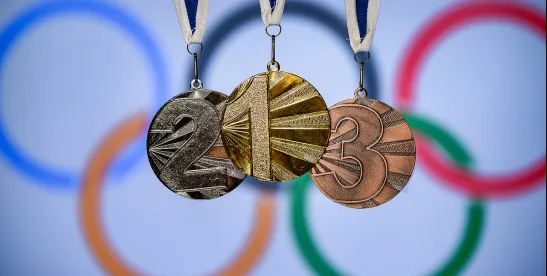The exact origins of Olympians competing naked are unclear. Perhaps it began when Spartan runner Acanthus showed up to race without the traditional loincloth on.[1] Or it could have been when Orsippus of Megara won his 185-meter run after embracing a loincloth slip, insisting that a naked man could run faster than one impeded by such clothing.[2] Regardless, it is clear that our Olympian predecessors competed unclothed.
Historians cite naked Olympic contests as a tribute to the Greek God Zeus:[3] athletes exhibited their muscular physiques to Zeus, simultaneously intimidating competitors.[4] Because heroes like Hercules or Achilles were often depicted naked in art, competing naked also meant that Olympians might be compared to these “true” heroes.[5]
Nudity and Gender Dynamics
Naked athletics would have been less shocking in ancient times in part because any sexualization of competitors was strictly prohibited given the religious nature of the Olympics.[6] Also at this time, both the competitors and the audience were male, with the additional benefit that viewers were primarily elite men who almost certainly shared similar cultural and religious backgrounds.[7] Women were not allowed to compete in Olympic Games until 1900, out of fear that seeing women’s bodies in action would be a distraction to men.[8] Consequently, even once allowed to compete, women were originally forced to wear modest and cumbersome clothes.[9] Female athletes have historically pushed the boundaries of athletic wear for women, daring to ditch corsets in favor of more functional wear as well as protesting uniform choices such as white shorts.[10]
Clothing Technology Today
Athlete Florence Griffith-Joyner, “Flo-Jo,” who ran the 200-meter sprint, once said, “Dress good to look good. Look good to feel good. And feel good to run fast!”[11] In more modern times, athletic wear and gear can actually improve an athlete’s game, rather than hinder it. Today, Olympic uniforms are “the epitome of fashion and function,” providing technical advantages along with style and comfort.[12] Athletes did not always wear the sleek, aerodynamic outfits we recognize today; for example, men once ran in long or baggy trousers.[13]
The swimsuit is one Olympic uniform whose basic design has not changed much over the years.[14] However, in 1912, athletes wore silk swimsuits, while today’s swimmers prefer synthetic materials, such as nylon.[15] Similar synthetic materials were first introduced to running uniforms in the 1970s.[16] These smooth materials, along with their compression features, help to reduce drag as athletes move through the air or water.[17] Cycling is another sport that has benefited from the technological advances in clothing. Riders previously wore ribbed undershirts to reduce drag, but now some track skinsuits incorporate ribbed lines directly down the back and sleeves to achieve the same benefits.[18] The most well-known examples of Olympic outfits taking advantage of these properties include Cathy Freeman’s 2000 Sydney Olympics winning Nike Swift Suit, known as the “supersuit,”[19] and the now-infamous LZR Racer swimsuit.
The LZR Racer swimsuit was created by Speedo (U.S. Patent No. 8,286,262), with the help of NASA scientists,[20] to mimic sharkskin.[21] The swimsuit is composed of 50% polyurethane[22] and has been shown to reduce drag and lower racing times by 1.9-2.2%.[23] The patent on polyurethane (U.S. Patent No. 3,479,310) was granted on November 18, 1969, and has since become one of the world’s most versatile polymers. Dr. Otto Bayer discovered polyurethane virtually by accident 80 years ago while leading research on polymers at IG Farben. The LZR Racer swimsuit was first worn at the 2008 Beijing Olympics, but was later banned from the Olympics in 2009 for giving competitors an unfair advantage.[24]
For the 2024 Paris Olympics, USA Swimming is outfitting American athletes in TYR Venzo swimsuits, which use ultra-smooth fibers to prevent water permeation and position swimmers’ bodies higher in the water.[25] The TYR Venzo also has patent-pending tapering and inner textile design features to support swimmers’ muscles.[26] Generally, clothing benefits athletes by streamlining the body and “bracing you together,” allowing muscle power to be better directed to the task at hand.[27] For instance, a weight belt and spandex can stabilize a weightlifter’s muscles, maximizing the amount of energy directly applied to the competitive feat.[28]
Technology Beyond Clothing
In many sports, the uniform itself is not the only area experiencing technological advancement. Shoes have also seen significant important improvements over time. For any events that involve running, jumping, or making quick turns, proper arch and heel support can increase performance and reduce the impact of these activities on lower limbs.[29] Over the years, shoes have become lighter.[30] Adidas’ ultra-light spikes, made from kangaroo leather and weighing roughly three ounces, helped British sprinter Ann Packer break the 800-meter world record.[31]
Technology has not only shaped the clothes that athletes wear, but also the design processes of this gear. Today, computational fluid dynamics simulations allow designers to precisely analyze material properties as well as aerodynamics and hydrodynamics, thereby eliminating the need for trial-and-error tests.[32] There will undoubtedly continue to be improvements in how design processes shape the technology worn by Olympians.
The technological innovations in Olympic gear have helped launch athletes to world-record-breaking achievements – far beyond those imaginable if competitors still competed in the nude.
- Brazil’s synchronized swimming team wore anatomically inspired suits in 2012, including a brain-like swim cap.
- Team USA’s Debi Thomas wore the first bodysuit in female figure skating in 1988. She later became the first Black athlete to win a medal at the Winter Olympics.
- The French Olympic team’s opening ceremony outfits in 1976 later inspired costume designers for Harry Potter and the Goblet of Fire.
- Katarina Witt of East Germany wore an ice princess look complete with a tiara in 1984.
- Michael Johnson, competing for the United States in 1996, wore custom gold Nikes.
- In contrast, Zola Budd of Great Britain broke records for the 3,000- and 5,000-meter races while competing barefoot in Los Angeles in 1984.
Casey Lu Simon-Plumb contributed to this article
[1] Ann Beveridge, Olympics: They Used to Compete in the Nude, History News Network (Aug. 16, 2004), https://www.historynewsnetwork.org/article/olympics-they-used-to-compete-in-the-nude.
[2] Rachel Nuwer, What if Olympic athletes went back to competing naked?, BBC (July 25, 2021), https://www.bbc.com/future/article/20210723-what-if-olympic-athletes-went-back-to-competing-naked.
[3] Abigail Wyatt, Five Things You Didn’t Know About the Ancient Olympics, Southern Utah University (Aug. 12, 2016), https://www.suu.edu/blog/2016/08/naked-athletes-olympic-history.html.
[4] Id.
[5] Id.
[6] Nuwer, supra note 2.
[7] Id.
[8] Elizabeth Segran, An unsavory history of the Olympic Games in five outfits, Fast Company (July 20, 2021), https://www.fastcompany.com/90656670/an-unsavory-history-of-the-olympic-games-in-five-outfits.
[9] Id.
[10] Dina Gachman, From Corsets to Singlets, the Olympics Have Driven the Evolution of Women’s Sportswear, Smithsonian Magazine (July 22, 2024 10:47 AM), https://www.smithsonianmag.com/innovation/from-corsets-to-singlets-the-olympics-have-driven-the-evolution-of-womens-sportswear-180984732/.
[11] Gladys Lai, 31 of the most iconic Olympic fashion moments throughout history, Vogue (June 23, 2024), https://www.vogue.com.au/fashion/news/31-of-the-most-iconic-olympic-fashion-moments-throughout-history/image-gallery/b2345674ecb984b16d86ad4eca116201 (emphasis added).
[12] Id.
[13] Heather Murphy, When Sprinters Wore Baggy Shorts, Slate (Aug. 4, 2012 11:10 AM), https://slate.com/culture/2012/08/olympic-uniforms-from-loose-and-heavy-to-tight-and-dimpled-a-visual-history-of-olympic-sprinting-attire.html.
[14] William Barrios, How Olympic Uniforms Have Changed Over the Past 12 Decades (Nov. 11, 2021), https://www.buzzfeed.com/williambarrios/how-olympics-uniforms-have-changed-over-the-past-12-decades.
[15] Id.
[16] Murphy, supra note 11.
[17] Nuwer, supra note 2.
[18] Luke Friend, Are these Team GB’s new Olympic skinsuits?, Cycling Weekly (Aug. 10, 2023), https://www.cyclingweekly.com/products/are-these-team-gbs-new-olympic-skinsuits.
[19] Gachman, supra note 7.
[20] Nuwer, supra note 2.
[21] Speedo Fastkin – A History of the World’s Fastest Swimsuits, SwimSwam (Nov. 15, 2023),https://swimswam.com/speedo-fastskin-a-history-of-the-worlds-fastest-swimsuits-2/.
[22] Full Body Swimsuit Now Banned for Professional Swimmers, ABC News (Dec. 28, 2009, 4:49 PM), https://abcnews.go.com/Politics/full-body-swimsuit-now-banned-professional-swimmers/story?id=9437780 [hereinafter Swimsuit Now Banned].
[23] Philip Brasor, Celebrity rules as the Olympics strays far from its ideal, The Japan Times (Aug. 10, 2008), https://www.japantimes.co.jp/news/2008/08/10/national/media-national/celebrity-rules-as-the-olympics-strays-far-from-its-ideal/.
[24] Swimsuit Now Banned, supra note 22.
[25] Jean E. Palmieri, Katie Ledecky to Sport Tyr Kit for Upcoming Paris Games, Women’s Wear Daily (Apr. 10, 2024 12:06 PM), https://wwd.com/fashion-news/fashion-scoops/katie-ledecky-tyr-kit-paris-olympics-speedo-1236307729/.
[26] Id.
[27] Nuwer, supra note 2.
[28] Id.
[29] Id.
[30] Murphy, supra note 11.
[31] Id.
[32] How Technology Is Transforming the Game for Olympic Apparent and Footwear, Cadence (Apr. 18, 2024), https://community.cadence.com/cadence_blogs_8/b/corporate/posts/how-technology-is-transforming-the-game-for-olympic-apparel-and-footwear.





 />i
/>i
